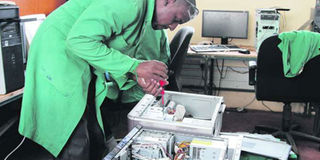Tips on how to solve common computer problems

A technician fixing a computer. With a cool head and a little know-how, however, it’s easy to fix the most common computer problems. PHOTO | JENNIFER MUIRURI | NATION MEDIA GROUP
What you need to know:
- With a cool head and a little know-how, however, it’s easy to fix the most common computer problems.
- If your system is frozen, resist the urge to pull the plug. Pressing and holding the power button for five to seven seconds should shut down the equipment.
- It’s a clever phishing trick that hackers use to gain access to your money. Make sure your antivirus and anti-spyware software is updated.
Your sound card has stopped working, your computer seems sluggish, the network is down, your hard drive is clicking, you can’t view a website, your monitor is hard to read, your new webcam isn’t working, your favourite programme won’t run, and a funny burning smell is coming from your computer.
With problems like these, you feel like pulling off your hair, especially because nowadays we are so tech dependent.
With a cool head and a little know-how, however, it’s easy to fix the most common computer problems.
First, restart your computer. Shutting down is a good first step for just about any electronic device that is frozen, has stopped functioning as it should, or has given you a cryptic error.
From computers to printers, routers, even personal electronics like MP3 players and cell phones, you’d be surprised how often a random problem just never returns after a system re-boot.
COMPUTER REBOOT
If your system is frozen, resist the urge to pull the plug. Pressing and holding the power button for five to seven seconds should shut down the equipment.
In case you are using a desktop, make sure you restart the computer tower or CPU, not just the monitor.
If restarting the system or device doesn’t work, try shutting down and unplugging the tower from the wall before plugging it back in and restarting.
If you have a laptop or other portable electronic device, remove the battery (if possible) to ensure that your system has fully re-booted.
In many cases, the reason why you could be experiencing power related problems with your gadget is because of the cables.
You will be surprised how easy it is for cables to get pulled loose. Check all cables in and out of the device, at both sides of the connection. This can save you pointless hours and anguish.
UPDATED SOFTWARES
Sometimes your computer just gets slow. In most cases it is caused by viruses, especially spyware that has been installed on your computer.
It can enter via a click on a link to a fake website from an e-mail. Often the e-mail is sent from what looks like your bank, Paypal, Facebook or what you would look like a trusted source.
The problem can also be caused by hardware – perhaps some memory you just installed – or recent software updates, including windows update.
To prevent this, check the link you are clicking by holding the cursor over it to see the link’s full address.
Does it look suspicious? Never give out your passwords or credit card information to anyone, even if it seems like your bank requires you to verify your account.
It’s a clever phishing trick that hackers use to gain access to your money. Make sure your antivirus and anti-spyware software is updated.
Most antivirus programmes can be set to automatically check for new updates.
RESTARTING PROCESS
If you are sure that your computer is spyware free, the problem may be due to outdated hardware drivers. Please consult a qualified technician to check whether the drivers are a problem.
When your Internet network goes down, there’s a specific order in which you should restart the various parts. If you have a high speed Internet connection and more than one computer, most likely you have a modem and a router.
If one or all of the systems on your network can no longer get online, shut down all systems that can’t get online, the modem and the router.
Shutting off a modem or router often requires disconnecting the power cable.
You will know you have done it well when the lights on the unit turn off.
Turn them back on in the following order, allowing each device a few minutes to connect before moving on to the next: modem, router, and then computer.





